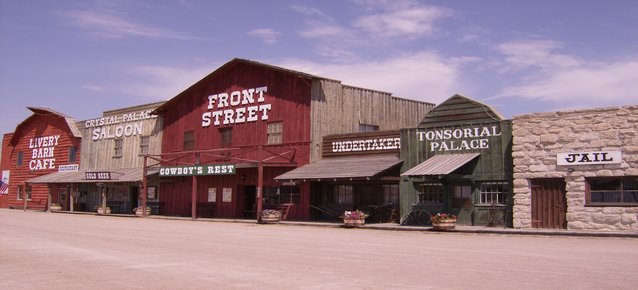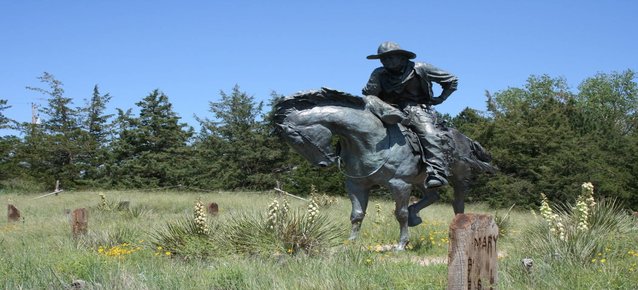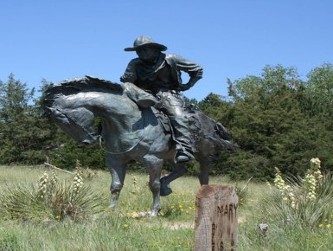
OGALLALA, Neb. (AP) – One day last month, a package arrived at the Ogallala/Keith County Chamber of Commerce offices bearing a long-lost firsthand account of the city’s Old West cowtown past.
Sent by a North Carolina woman, the package included two copies of the December 1878 issue of American Agriculturist, a New York-based monthly magazine launched in 1842 “for the farm, garden & household.”
Inside, a two-page article titled The Texas Cattle Drive offered a detailed discussion of the Texas Trail—its route, herds, Texas sellers and northern buyers and typical sale prices for different types of cattle.
It also provides a description and artistic illustration of 11-year-old Ogallala, which still celebrates its mid-1870s to mid-1880s heyday as the trail’s terminus.
The magazine’s sender apparently had no local ties, said Taylor Stone, social media and tourism coordinator for the Ogallala chamber.
“It was just like ‘I came across this, and here you go,’” she told The North Platte Telegraph.
“It was super out of the blue. But it was a great piece of mail to get, especially with these (COVID-19) times right now.”
The American Agriculturist article, which carries no byline, generally tracks with what local, Nebraska and Old West historians have written about the Texas Trail and Ogallala.
But it doesn’t show up in available print and online source lists. And it indicates that cattle began arriving in Ogallala in large numbers a year before the trail’s first known busy year in 1875.
“In 1874, the first year that Ogalalla was made the terminus of the drive, fifty thousand head of cattle reached here,” it says, using the late 1800s-early 1900s spelling of the city’s name with its double-L at the end instead of the middle.
“Last year, 1877, eighty thousand arrived. The number of cattle brought here this year (1878) and distributed to the ranchmen, is computed at one hundred and twenty thousand. …
“After the ranchmen have kept the cattle on their northern ranges for a year or more, they ship them to the Chicago market and make their profit on them.”
Historian Vance Nelson of Ogallala, a former curator of the Fort Robinson Museum and a Keith County Historical Society member, called the 1878 piece “a very, very important article for several reasons.”
Besides asserting an earlier start to Ogallala’s trailhead period, he said, it suggests the Texas Trail supplied not only eastern markets but also the Oglala and Brule Lakota bands being supplied by federal cattle buyers at the Red Cloud and Spotted Tail agencies in northern Nebraska.
The Keith County seat near Lake McConaughy has actively promoted itself as “The End of the Texas Trail” since the runup to Nebraska’s centennial celebration in 1967.
Front Street, which opened in 1964, memorializes the trail era’s Crystal Palace and Cowboy’s Rest saloons. Boot Hill, which once held the graves of early settlers and cowboys who met unfortunate ends, sits north of downtown.

For about two decades after the Civil War, Texas ranchers drove their cattle north, generally starting in the spring, to reach the Union Pacific or Kansas Pacific railroads and sell them for shipment eastward.
Schuyler, Columbus, Kearney, North Platte, Ogallala and Sidney took turns as trailheads as the Texans shifted their route west to avoid Kansas farmers and their fences.
Founded as a Union Pacific water stop in 1867, Ogallala didn’t become the trail drives’ main target until after the railroad built cattle pens and chutes just west of town in 1874.
That fact appears in several books and historical articles, including North Platte author Nellie Snyder Yost’s 1966 book The Call of the Range and Ogallala journalist Elaine Nielsen’s 1984 book Ogallala: A Century on the Trail.
Those works listed 1875—when 75,000 head came north—as Ogallala’s debut as a major cowtown. More than 100,000 head arrived most years through 1884.
When the American Agriculturist writer visited there, Ogallala was a tiny town that swelled with hundreds of cowboys and thousands of cattle every spring. (Subsequent quotes from the 1878 article will substitute the city’s modern spelling.)
“The first house at Ogallala was built in 1870, and though there are now not more than twenty buildings, all told, the place, during the cattle season, is full of bustle and excitement,” the article says.
Ogallala was a logical choice for the Union Pacific trailhead because “the cattle could no longer be driven to any point eastward without encountering improved lands, and it was not feasible to drive them to any point west of Ogallala, owing to the difficulty they would experience in procuring water en route.”
The 1878 article gives the names of the Texas Trail’s most active Lone Star State cattlemen, detailed sales prices for different types of cattle and the costs of shipping them as far east as Chicago.
Herds of 1,000 to 3,500 head would leave Texas in early February, driven by an eight- to 10-man crew and 30 to 40 horses.
Cattle would arrive at Ogallala between early May and September, with some of them rushed from northern Texas when a rancher saw a chance to make more money at the railhead by supplementing his herd.
While waiting to load the cattle at the Union Pacific pens north of the tracks, cattle would “graze up and down the south side of the (South) Platte over an area forty miles long and from one and a half to four miles wide,” the American Agriculturist writer said.
“All the horses are sold when the cattle are delivered at the end of the drive. As fast as the owner disposes of the cattle, and the cowboys can be spared, he pays them off, when they at once proceed to indulge in what they term ‘a little amusement.’
“The sharpers and gamblers who have reached Ogallala from various points, are always ready to accommodate the cowboys in their search for ‘amusement,’ and they are fortunate if they do not leave a considerable portion of their wages with the Spanish Monte and Faro (card) dealers.
“It very frequently happens that they do not have enough money left to pay their way back to Texas by (train) cars, and are therefore compelled to mortgage their next season’s wages.”
___
By TODD VON KAMPEN, North Platte Telegraph
Copyright 2020 Associated Press. All rights reserved. This material may not be published, broadcast, rewritten, or redistributed.
AP-WF-04-18-20 0501GMT



